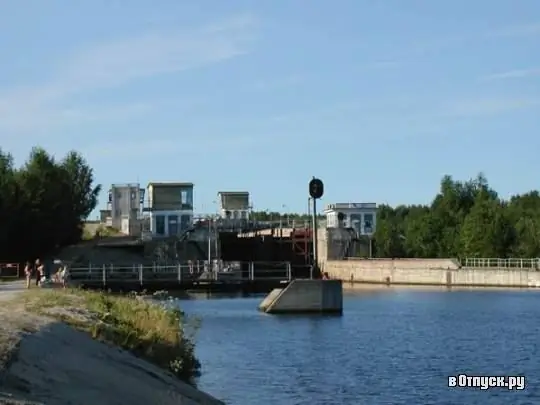
Description of the attraction
The White Sea-Baltic Canal is a canal that connects Lake Onega with the White Sea and has access to the Baltic Sea, as well as to the Volga-Baltic waterway. In addition, this historical and cultural complex is a large system of hydraulic structures and structures, administrative buildings and houses, as well as memorial places of burial of political prisoners who died in Stalin's time.
The decision to build the White Sea-Baltic Canal was made back in 1930, and already in July 1931 the first sketches of the project were considered by the Soviet government. A month later, design work began on the implementation of the construction plan. The project was finally approved only in February 1932, but its construction was started already at the end of 1931.
The canal was built between 1931 and 1933, which is a record fast for this kind of buildings, and its builders erected it using shovels, axes, sledgehammers and chisels. The building materials for the construction of the canal were wood, sand and stone. Its opening took place on August 2, 1933. The canal is 227 km long, including 19 locks. The White Sea-Baltic Canal is considered the pride of 1929-1932, i.e. the first five-year plan.
The most significant feature of this building is not only in the technical achievements of the canal, which has more than 100 complex hydraulic engineering facilities and 2,500 railway tracks, built in just 1 year and 9 months. The construction of the canal was carried out by more than one hundred thousand prisoners. The supervisors of the construction were Genrikh Yagoda - later the Stalinist People's Commissar and Matvey Berman - the head of the GULAG itself. During the construction of the canal in the period from 1931 to 1933, the process was led by N. A. Frenkel. This man is also credited with the idea that prison inmates at the largest national economic construction sites acted as a labor force. In addition, the leadership included: E. I. Senkevich, S. G. Firin and P. F. Alexandrov.
It is known that during the entire construction period the prisoners have completed more than 21 million cubic meters. meters of earthworks, created 37 km of artificial tracks and moved the railway of the city of Murmansk, which was blocking earthworks. The ration of prisoners depended on the performance of each: the less the prisoner worked, the less he received ration, and for good and productive work, the ration was increased. The standard ration consisted of 0.5 kg of bread, as well as seaweed gruel.
According to official data, during the construction of the canal in BelBaltLag, 1,438 prisoners died in 1931 (2, 24% of the number of workers), in 1932 - 2010 people (2, 03%), in 1933, 8,870 prisoners (10, 56%) of - for hunger in the country and all hands-on work before the completion of construction. According to other sources, from 50 to 200 thousand people died during the construction of the canal (according to various sources). After the completion of construction on August 4, 1933, 12,484 prisoners were released, the terms for 59,516 prisoners were reduced.
The White Sea-Baltic Canal, connecting the White Sea and Lake Onega, encircles three regions of Karelia. The beginning of the canal was laid near the town of Povenets, or rather in the Povenets Bay of the lake. In the distant past, this remote northern village was a place of exile. At the moment Povenets is a large lake and river port.
The southern Onega slope of the canal is considered the steepest, because there are 7 locks on it. The motor ships going north from Lake Onega rise to a height of 70 meters along the Povenchanskaya Stairs. The descent, which leads towards the White Sea, is more gentle. Locks, in the amount of 12 pieces, lower the ship to Belomorsk by more than one hundred meters.
During the Great Patriotic War, the part of the canal located in the south was almost completely destroyed. By 1946, the canal had already been restored, putting it into operation. It is worth considering that the canal was structurally updated, and then it became possible to allow the movement of large-tonnage vessels along it.
The White Sea-Baltic waterway later also became a powerful industrial and transport complex, which gave life not only to Belomorsk, but also to Segezha, Nadvoitsy and the forest region located from the White Sea to Lake Onega.






